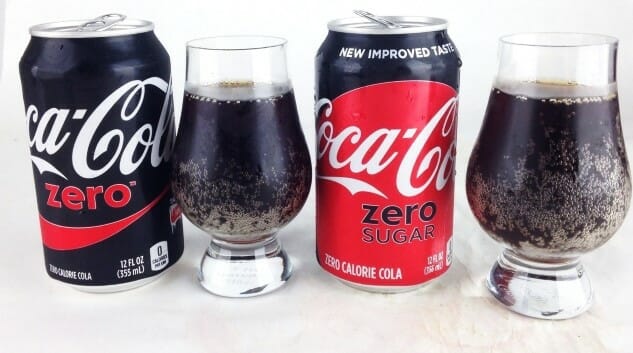A schism has come to the Coca-Cola faithful. Coke Zero, prized by many as a superior alternative to the tinny artificiality of Diet Coke, is being replaced by an altered new product known as “Coke Zero Sugar.” The new version retains some of the elements of the old, such as the partially black can, but hearkens back to the original Coca Cola Classic by increasing the amount of red. The message is clear: This product is intended to come off as even closer to the “regular” Coke, which was already the advantage that Coke Zero had going for it over Diet Coke. After having been tested with considerable success in dozens of countries outside the U.S., the company now feels confident enough to bring Coke Zero Sugar to the home market, where it will begin displacing older packages of Coke Zero in stores immediately.
We received this news with a bit of trepidation at Paste. Several of us are pretty regular Coke Zero drinkers, including both myself and staff writer Jason Rhode, who only last month wrote an amusing essay about how he and Coke Zero were able to forge a tenuous alliance after initial misgivings. For myself, Coke Zero is the zero-calorie cola I also settled on as my preferred grocery store pick. It’s not a recipe I wanted to see messed with in a significant way.
So, before we taste, let’s first answer the obvious question: How is this new product any different than Coke Zero? The answer, as it turns out, is “not by much.” It’s using the same artificial sweeteners as Coke Zero was—rather, the change is to the “secret formula” portion of the recipe, such as the array of cola spices. In Coke’s words:
Like Coke Zero, Coke Zero Sugar is sweetened with aspartame and acesulfame K. We only tweaked the blend of natural flavors, which are proprietary to Coca-Cola, so the ingredient list on the Nutrition Facts Panel on cans and bottles is the same (visit Coca-Cola Product Facts for the details). Simply put, we’ve made the great taste Coke Zero fans love even better and a lot like a Coke.
Sounds simple enough, but the taste test will prove whether this is all true. Curious how they would come off when compared side to side, we dipped into our stash of the previous Coke Zero to compare it with the new Coke Zero Sugar, in much the same style as our series of craft beer blind tastings. Here’s what we found.
Coke Zero vs. Coke Zero Sugar taste test
The first thing to note is that the ultimate difference between these two is not extreme—certainly less marked than the difference between Coke Zero and Diet Coke, or the difference between Coke and Pepsi. But there are certainly some differentiating factors that become obvious when tasting side by side.
Coke Zero
The “original” Coke Zero is very much “old timey cola” on the nose, with notes of cola nut, cinnamon and sweet spices. On the palate, it’s honestly a little bit nondescript: Semisweet standard cola, with a slight medicinal note on the back end. It would be a mistake to describe it as “not sweet,” because it is, but in comparison to the Coke Zero Sugar it’s drier and slightly sharper and more “tinny,” in a way that isn’t necessarily unpleasant—just different. It certainly finishes more crisply than Coke Zero Sugar does, and is just a drier cola in general, which one might argue boosts its drinkability or the likelihood of finishing a whole can.
Coke Zero Sugar
From the moment of first sip, it’s difficult to deny that Coke Zero Sugar doesn’t taste more like Coca Cola Classic than its predecessor—it just does. If you immediately react in a negative way toward Coke Zero Sugar, then you’re probably not a big fan of the classic Coca Cola taste profile, because that’s what they’re trying to replicate here. The nose is similar, but more layered with vanilla and brown sugar. On the palate it’s noticeably sweeter, with a slightly more syrupy texture and rounded mouthfeel. It’s a more overtly “sugary” type of sweetness that Jason Rhode described as a “sugar lift,” noting “It does a better job of fooling my taste buds into believing that they’re drinking a can of Coca Cola Classic.” The sweetness affects the entire flavor profile, giving a note that I have written down as “maraschino cherry.”
Is this better, or worse than Coke Zero? That, I’m afraid, will depend on your perception. Some may decry Coke Zero Sugar as too sweet or syrupy, while others may find it closer to what they always wanted from Coke Zero in the first place. I find myself falling somewhere in the middle for now. In tasting the two side by side, I picked up more tinny artificiality in Coke Zero than I have in the past, but at the same time the sweetness of Coke Zero Sugar made me feel like I might be less likely to finish a full can at any given time. I immediately wanted to try pouring the Coke Zero Sugar over ice, which might also have a measurable effect in balancing the sweetness.
Regardless, I really don’t think that Coke has created some kind of monster here. There will be legions of detractors because there ALWAYS are when any Coca Cola recipe is changed, but of the people I’ve met who have sampled Coke Zero Sugar, more of them are leaning in a positive direction than a negative one. It may require a little bit of adjustment, but considering that all I’ve ever really wanted was a zero calorie version of Coke that tasted like Coke, I don’t see myself complaining about it in the future. This is one case where “new and improved” might not be hyperbole.
Jim Vorel is a Paste staff writer, beer taster and Coke Zero drinker. You can follow him on Twitter.
